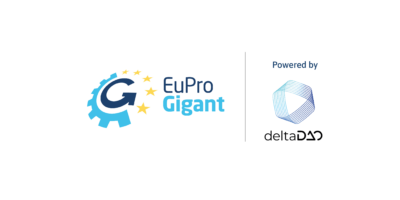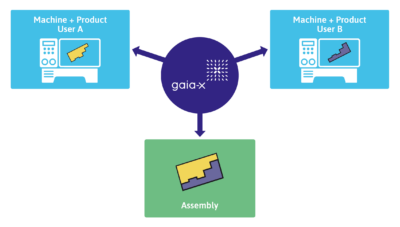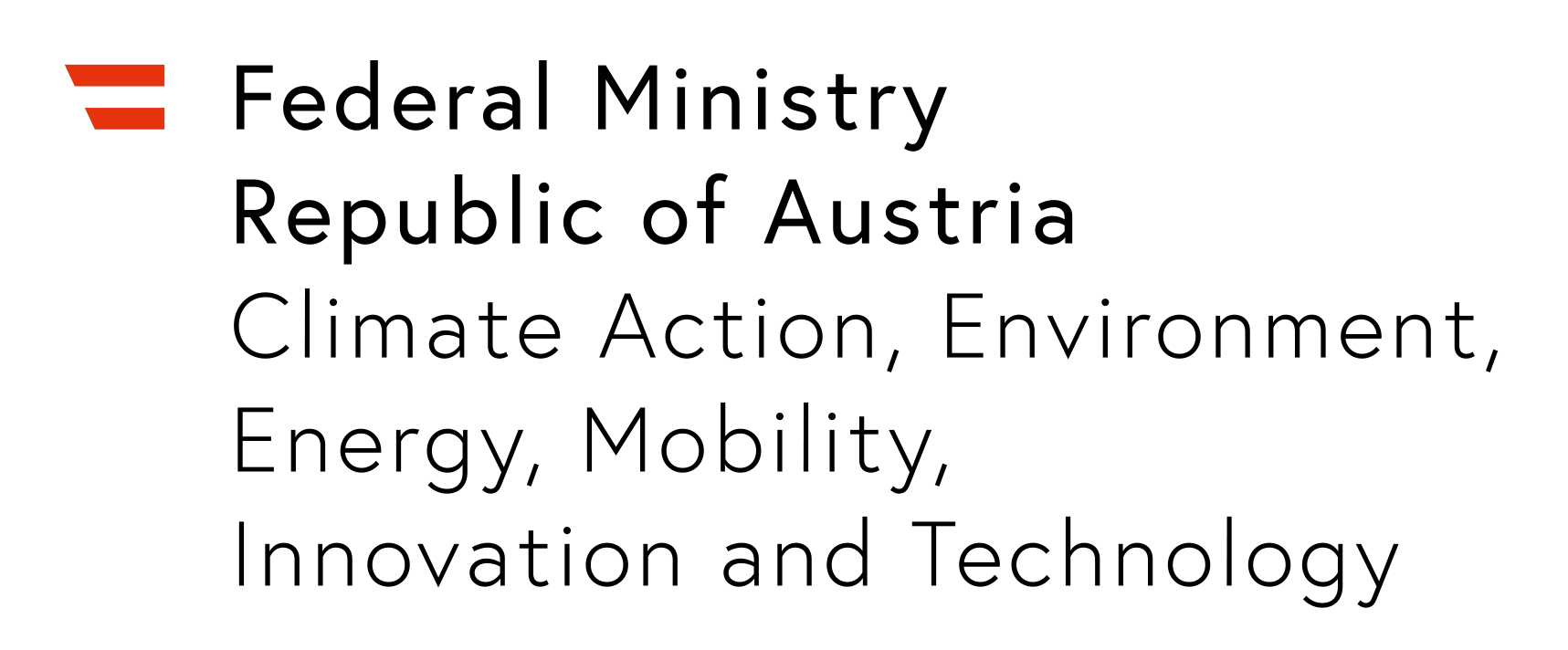Experience Gaia-X!
Discover the EuProGigant Portal
The connection to the new European data infrastructure made its grand debut at HANNOVER MESSE 2022. EuProGigant’s demonstrator showed visitors how the data of two connected machines at different locations flow together on one platform and are made available, securely and decentralised, via the Gaia-X Web3 Demonstrator of deltaDAO AG.

The EuProGigant Portal
The EuProGigant Portal functions as a decentralized, customisable marketplace for data service offerings. It is your entry point to interact with Gaia-X Offerings from the Federated Catalogue.
What can you do?
The EuProGigant Portal provides the first look and feel of the automation of business processes with Gaia-X that lead to an automated data offering right from the edge near your production equipment on the shop floor. After an onboarding process by deltaDAO, you can test out an auto-publishing workflow, consisting of these five steps:
- “create and store data set from various timeseries data and according meta data”,
- “automatic filling of self-descriptions based on a template and associated meta information”,
- “self-sign self-description to become a verifiable credential”,
- “get thefor the self-signed self-description which includes the signature from the Gaia-X Compliance Service”,
- “publish data service offering in the Federated Catalogue”
Eventually, this set-up will allow businesses to set up their own portal where they can display their data service offerings in the Federated Catalogue.
How does it work?
The system is designed to make sure there is no vendor lock-in. We adhere to the principle of “owned by no one and open to everyone”.
We have implemented a combination of a deltaDAO technology stack, based on web3 technology, and EuProGigant edge computing technologies which serve as Gaia-X nodes in the infrastructure ecosystem. This ensures an affordable and open platform. Furthermore, Gaia-X on Edge leads to full trust and resilience at the shop floor level, flexibility and reduced energy and data consumption.
Compute-to-Data and Compute-to-Edge
Compute-to-Data (CtD) allows for data to stay on-premises while other companies can run compute jobs on that data. The data must not be transferred to third parties any more to allow them to process data analytics on it. CtD allows for easier and more secure data sharing, as data owners do not have to relinquish control over their data. Clear rules for trust and policies regarding the algorithm enabled for CtD is needed.
Compute-to-Edge (CtE) completes the edge-to-cloud continuum. CtE is the application of compute-to-data directly at the edge, enabling technical data sovereignty where the data originates. This way, unnecessary replication, transport, and storage of data can be avoided, reducing the data footprint. CtE allows for AI-based manufacturing predictions and predictive maintenance on sensitive sensor data. The data can stay with the machine. This enables a sovereign data fabric across fleets of edge device.
Gaia-X compliance
EuProGigant demonstrates Gaia-X compliant self-descriptions. This means that our Portal adheres to the Gaia-X Trust Framework, which verifies the existence and veracity of participant and service offering characteristics. The Trust Framework makes sure that data protection, transparency, security, portability and flexibility are safeguarded.
The latest version of the Compliance Service has been integrated into the EuProGigant portal and self-descriptions have been created for the entire EuProGigant infrastructure in accordance with the latest version of the Gaia-X Trust Framework. These are validated in real time by the Gaia-X Compliance Service.
Our use case demonstrators
As a Gaia-X lighthouse project, EuProGigant demonstrates the current state of technology implementation according to the Gaia-X Framework. We have a total of four use cases, provided by our industry partners, that demonstrate Gaia-X technologies in industry-relevant settings.
EuProGigant takes a “use case to business case” approach. Starting from these use cases, the project defines business cases for each of the demonstrated use cases and investigates their interoperability.
Three use cases have working demonstrators: the validation platform, ideal component matching, and CO2 footprint in production engineering and manufacturing.
The validation platform
The data volumes required for condition monitoring present small and medium-sized enterprises (SMEs) with numerous challenges – they often do not have the needed number of identical machines to generate sufficient operating data, or the capabilities to analyse existing data.
The validation platform enables service creation based on data sets from different machine tools across company borders. The platform relies on the Gaia-X data infrastructure and ensures secure and sovereign data exchange between production companies. As such, the validation platform functions as a commonly accepted and verifiable source for information validation. The validation platform puts condition monitoring of manufacturing processes in focus and shows how SMEs can collaborate in creating the necessary database.
One use case of the validation platform is the classification of a good or bad cutting tool in the manufacturing process. This use case was successfully debuted at HANNOVER MESSE 2022, after which it has been demonstrated at numerous other events and trade fairs.
Ideal component matching
Machine parts are usually produced at multiple companies, which means that there can be size deviations in the produced parts. All producers should adhere to certain tolerances for their produced parts, to make sure that these parts can be matched. In practice, however, parts often deviate from these tolerances leading to extra work to adapt these parts, more inventory or even waste.
Our vision is to make tolerances fluent. With a digital platform for component matching, search efforts for product assembly will be minimised and higher speed of value creation can be achieved. It can also pave the way towards zero-waste and zero-defect manufacturing and paperless production. Furthermore, it allows for standardised and automated information transfer, part and information traceability and reporting.
CO2 footprint in production engineering and manufacturing
Companies that want to stay competitive in the future will have to consider sustainability measures. The manufacturing process offers a good opportunity to get a head start.
In this demonstrator, holding clamps were manufactured in different materials, such as aluminium or plastic, and produced using different processes, such as 3d printing, metal cutting or injection moulding. Using compute-to-edge, we demonstrate CO2-equivalent (CO2e) emission reporting per manufactured part. Companies will be able to publish their data sets and algorithms securely on the Portal.
If you’re interested to learn more about how this use case can pave the way to a more sustainable manufacturing process, please read our paper on the topic.








